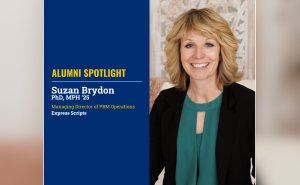The Hearing Aid Revolution: Cheaper and Easier to Get

Interview by Brian W. Simpson
New FDA guidelines are poised to upend the hearing aid market in the U.S., dropping the cost of devices by as much as 90% for those with mild to moderate hearing loss.
The proposed FDA rule, published October 20, allows hearing aids to be sold directly to consumers without an exam or fitting by an audiologist. About 37.5 million American adults have some trouble hearing, but only 16% have ever used a hearing aid, according to the National Institute on Deafness and Other Communication Disorders. Current costs for hearing aids can be $4,000 to $5,000—one reason why so few Americans who need them actually use them. The devices are not covered by Medicare or by most private insurance plans.
When the guidelines go into effect as soon as next fall, the U.S. will be the first country to have a regulated market for over-the-counter hearing aids, says Frank Lin, MD, PhD ’08, director of the Cochlear Center for Hearing and Public Health at the Bloomberg School.
“It’s exciting, and invariably where the U.S. goes, it’s going to have trickle down effects on the rest of the world market,” say Lin, who worked on reports from the National Academies of Sciences and White House that influenced 2017 legislation leading to the new FDA guidelines.
In the following Q&A, Lin explains what’s in the new rule, why it’s likely to bring companies like Apple and Samsung into the hearing aid market, and how soon new, cheaper hearing aids will be available.
Why is this proposed new rule by the FDA a big deal?
The idea that FDA now is finally enacting legislation that we got passed four years ago is exciting because it solves a public health problem through a market-shaping strategy.
They got the regulations right in the sense that there is a very clear glide path for companies like Apple, Samsung, and Bose to enter the hearing aid market. And that shapes the whole dynamic very quickly around stigma, access, cost—everything.
What’s in the proposed rule? Is it focused on the market? Policies or technology?
Everything in a way. The law told FDA to establish a new regulatory classification for hearing aids that could be explicitly sold over the counter and would be safe and effective. It sounds simple, like, Oh, just put a bunch of regulations together and just throw it out there. But it’s actually not simple. The FDA had to create a new regulatory class that then preempts state law, and that opens up a whole legal morass. It took a lawyer a lot of time to think through all these scenarios. The nitty gritty, the trickle-down effects on other standards is not easy.
You served on a National Academies committee and advised the White House on reports that led to this proposed rule. Is this what you were looking for?
Yes, amazingly so. There was a lot of concern that the established hearing industry was trying to influence the rule, so these hearing aids wouldn’t be able to help the greatest number of people who could benefit from these OTC devices. In the end, these regulations followed the exact spirit of the truly bipartisan bill, which is fundamentally to drive access and affordability, competition, and innovation. The FDA has set clear guideposts, but it’s not overly restrictive. It’s not going to prevent a company from like Apple, Samsung, or Bose from entering the market.
I can understand why this will lead to greater affordability. Why will this rule increase innovation?
Right now, five multinational companies control more than 90% of the global marketplace for hearing aids. And this is possible because it’s a low-volume, high-margin market where the audiologist is the gatekeeper to these technologies for patients and consumers. But when manufacturers can sell directly to the consumer and retail market, this fundamentally changes that business model. It affects how the companies think about innovation and being directly responsive to consumer needs. Large consumer technology companies like Apple and Bose that are already making innovative hearing technologies currently can’t enter the hearing aid market because they wouldn’t be permitted to sell these hearing aids directly to consumers. These new regulations from the FDA will change this.
Tell us what’s going to happen next. When will we see these OTC hearing aids actually on store counters?
I think really 11 months from now is when we’re going to probably begin to see the devices in the market.
Say I’m 70 years old, and I think I’ve got hearing issues. Will I just go to Best Buy or Amazon to buy some new hearing aids? Or do I still need to go to the audiologist?
That’s the beauty of it. Before, it was very much a medical model. You theoretically had to see a physician first and then go to an audiologist. When these devices are available, it would just be like buying a pair of reading glasses or headphones.
What else will change?
There’s increasingly a convergence between what’s a consumer electronic device versus what is a health care device. Apple’s a perfect example. An Apple Watch nowadays can monitor for atrial fibrillation—so is it consumer tech, or is a health device? It’s sort of both, right? These regulations essentially allow that convergence to happen on a much faster scale than it would have. For the five hearing aid companies that are out there, trying to integrate their technologies seamlessly with consumer electronics is likely a lot harder than [it is for] a company like Apple or Samsung integrating a hearing aid feature into their existing platforms.
There are already devices out there now that help hearing, but they’re not allowed to be called hearing aids. Is that right?
Yes, they fit in this gray area called personal sound amplification products, or PSAPs. These are completely unregulated devices not intended for hearing loss, and yet some of them are being passed off as hearing aids despite being completely ineffective. The problem is that consumers can’t tell the difference and have no idea whether that device is safe or effective.
Would you ever buy an unregulated bottle of acetaminophen? There’s no way you would. And that’s why these OTC regulations for hearing aids are so important. Someone can go into a store and know these devices are safe and effective.
Brian W. Simpson, MPH ’13, is the editorial director at the Bloomberg School.
Note: This interview has been edited and condensed for clarity.
Related:
More from the Bloomberg School
- See latest headlines
- Learn more about our departments:





